Buckingham Palace
Coordinates: 51°30′3″N 0°8′31″W / 51.50083°N 0.14194°W
.jpg)
Buckingham Palace (UK: /ˈbʌkɪŋəm
Originally known as Buckingham House, the building at the core of today's palace was a large townhouse built for the Duke of Buckingham in 1703 on a site that had been in private ownership for at least 150 years. It was acquired by King George III in 1761[4] as a private residence for Queen Charlotte and became known as The Queen's House. During the 19th century it was enlarged, principally by architects John Nash and Edward Blore, who constructed three wings around a central courtyard. Buckingham Palace became the London residence of the British monarch on the accession of Queen Victoria in 1837.
The last major structural additions were made in the late 19th and early 20th centuries, including the East front, which contains the well-known balcony on which the royal family traditionally congregates to greet crowds. The palace chapel was destroyed by a German bomb during World War II; the Queen's Gallery was built on the site and opened to the public in 1962 to exhibit works of art from the Royal Collection.
The original early 19th-century interior designs, many of which survive, include widespread use of brightly coloured scagliola and blue and pink lapis, on the advice of Sir Charles Long. King Edward VII oversaw a partial redecoration in a Belle Époque cream and gold colour scheme. Many smaller reception rooms are furnished in the Chinese regency style with furniture and fittings brought from the Royal Pavilion at Brighton and from Carlton House. The palace has 775 rooms, and the garden is the largest private garden in London. The state rooms, used for official and state entertaining, are open to the public each year for most of August and September and on some days in winter and spring.
History
Site
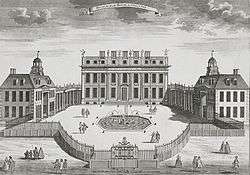
In the Middle Ages, the site of the future palace formed part of the Manor of Ebury (also called Eia). The marshy ground was watered by the river Tyburn, which still flows below the courtyard and south wing of the palace.[5] Where the river was fordable (at Cow Ford), the village of Eye Cross grew. Ownership of the site changed hands many times; owners included Edward the Confessor and his queen consort Edith of Wessex in late Saxon times, and, after the Norman Conquest, William the Conqueror. William gave the site to Geoffrey de Mandeville, who bequeathed it to the monks of Westminster Abbey.[lower-alpha 2]
In 1531, Henry VIII acquired the Hospital of St James, which became St James's Palace,[6] from Eton College, and in 1536 he took the Manor of Ebury from Westminster Abbey.[7] These transfers brought the site of Buckingham Palace back into royal hands for the first time since William the Conqueror had given it away almost 500 years earlier.[8]
Various owners leased it from royal landlords and the freehold was the subject of frenzied speculation during the 17th century. By then, the old village of Eye Cross had long since fallen into decay, and the area was mostly wasteland.[9] Needing money, James I sold off part of the Crown freehold but retained part of the site on which he established a 4-acre (16,000 m2) mulberry garden for the production of silk. (This is at the northwest corner of today's palace.)[10] Clement Walker in Anarchia Anglicana (1649) refers to "new-erected sodoms and spintries at the Mulberry Garden at S. James's"; this suggests it may have been a place of debauchery. Eventually, in the late 17th century, the freehold was inherited from the property tycoon Sir Hugh Audley by the great heiress Mary Davies.[lower-alpha 3]
First houses on the site
Goring House
Possibly the first house erected within the site was that of a Sir William Blake, around 1624.[11] The next owner was Lord Goring, who from 1633 extended Blake's house and developed much of today's garden, then known as Goring Great Garden.[12][13] He did not, however, obtain the freehold interest in the mulberry garden. Unbeknown to Goring, in 1640 the document "failed to pass the Great Seal before King Charles I fled London, which it needed to do for legal execution".[14] It was this critical omission that helped the British royal family regain the freehold under King George III.[15]
Arlington House
The improvident Goring defaulted on his rents;[16] Henry Bennet, 1st Earl of Arlington obtained the mansion and was occupying it, now known as Goring House, when it burned down in 1674.[13] Arlington House rose on the site—the location of the southern wing of today's palace—the next year.[13] In 1698, John Sheffield, later the first Duke of Buckingham and Normanby, acquired the lease.[17]
Buckingham House
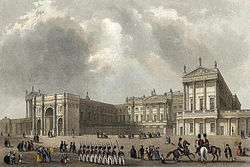
The house which forms the architectural core of the palace was built for the first Duke of Buckingham and Normanby in 1703 to the design of William Winde. The style chosen was of a large, three-floored central block with two smaller flanking service wings.[18] Buckingham House was eventually sold by Buckingham's natural son, Sir Charles Sheffield, in 1761[4] to George III for £21,000.[19][lower-alpha 4] Sheffield's leasehold on the mulberry garden site, the freehold of which was still owned by the royal family, was due to expire in 1774.[20]
From Queen's House to palace
Under the new Crown ownership, the building was originally intended as a private retreat for King George III's wife, Queen Charlotte, and was accordingly known as The Queen's House. Remodelling of the structure began in 1762.[21] In 1775, an Act of Parliament settled the property on Queen Charlotte, in exchange for her rights to Somerset House,[22][lower-alpha 5] and 14 of her 15 children were born there. Some furnishings were transferred from Carlton House, and others had been bought in France after the French Revolution[23] of 1789. While St James's Palace remained the official and ceremonial royal residence,[22] the name "Buckingham-palace" was used from at least 1791.[24]
After his accession to the throne in 1820, King George IV continued the renovation with the idea in mind of a small, comfortable home. But while the work was in progress, in 1826, the King decided to modify the house into a palace, with the help of his architect John Nash.[25] The external façade was designed keeping in mind the French neo-classical influence preferred by George IV. The cost of the renovations grew dramatically, and by 1829 the extravagance of Nash's designs resulted in his removal as architect. On the death of George IV in 1830, his younger brother King William IV hired Edward Blore to finish the work.[26][27] After the destruction of the Palace of Westminster by fire in 1834, William considered converting the palace into the new Houses of Parliament.[28]
Home of the monarch
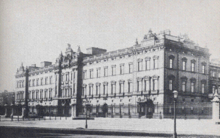
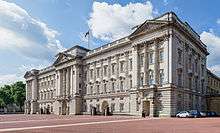
Buckingham Palace finally became the principal royal residence in 1837, on the accession of Queen Victoria,[29] who was the first monarch to reside there; her predecessor William IV had died before its completion.[30] While the state rooms were a riot of gilt and colour, the necessities of the new palace were somewhat less luxurious. For one thing, it was reported the chimneys smoked so much that the fires had to be allowed to die down, and consequently the court shivered in icy magnificence.[31] Ventilation was so bad that the interior smelled, and when it was decided to install gas lamps, there was a serious worry about the build-up of gas on the lower floors. It was also said that staff were lax and lazy and the palace was dirty.[31] Following the Queen's marriage in 1840, her husband, Prince Albert, concerned himself with a reorganisation of the household offices and staff, and with the design faults of the palace.[32] By the end of 1840, all the problems had been rectified. However, the builders were to return within the decade.[32]
By 1847, the couple had found the palace too small for court life and their growing family,[33] and consequently the new wing, designed by Edward Blore, was built by Thomas Cubitt,[34] enclosing the central quadrangle. The large East Front, facing The Mall, is today the "public face" of Buckingham Palace, and contains the balcony from which the royal family acknowledge the crowds on momentous occasions and after the annual Trooping the Colour.[35] The ballroom wing and a further suite of state rooms were also built in this period, designed by Nash's student Sir James Pennethorne.[36]
Before Prince Albert's death, the palace was frequently the scene of musical entertainments,[37] and the greatest contemporary musicians entertained at Buckingham Palace. The composer Felix Mendelssohn is known to have played there on three occasions.[38] Johann Strauss II and his orchestra played there when in England.[39] Strauss's "Alice Polka" was first performed at the palace in 1849 in honour of the queen's daughter, Princess Alice.[40] Under Victoria, Buckingham Palace was frequently the scene of lavish costume balls, in addition to the usual royal ceremonies, investitures and presentations.[41]
Widowed in 1861, the grief-stricken Queen withdrew from public life and left Buckingham Palace to live at Windsor Castle, Balmoral Castle and Osborne House. For many years the palace was seldom used, even neglected. In 1864, a note was found pinned to the fence of Buckingham Palace, saying: "These commanding premises to be let or sold, in consequence of the late occupant's declining business."[42] Eventually, public opinion persuaded the Queen to return to London, though even then she preferred to live elsewhere whenever possible. Court functions were still held at Windsor Castle, presided over by the sombre Queen habitually dressed in mourning black, while Buckingham Palace remained shuttered for most of the year.[43]
Interior
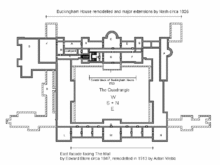
The palace measures 108 metres (354 ft) by 120 m (390 ft), is 24 m (79 ft) high and contains over 77,000 m2 (830,000 sq ft) of floorspace.[44] The floor area is smaller than the Royal Palace of Madrid, the Papal Palace and Quirinal Palace in Rome, the Louvre in Paris, the Hofburg Palace in Vienna, and the Forbidden City.[45] There are 775 rooms, including 188 staff bedrooms, 92 offices, 78 bathrooms, 52 principal bedrooms, and 19 state rooms. It also has a post office, cinema, swimming pool, doctor's surgery,[44] and jeweller's workshop.[46]
The principal rooms are contained on the piano nobile behind the west-facing garden façade at the rear of the palace. The centre of this ornate suite of state rooms is the Music Room, its large bow the dominant feature of the façade. Flanking the Music Room are the Blue and the White Drawing Rooms. At the centre of the suite, serving as a corridor to link the state rooms, is the Picture Gallery, which is top-lit and 55 yards (50 m) long.[47] The Gallery is hung with numerous works including some by Rembrandt, van Dyck, Rubens and Vermeer;[48] other rooms leading from the Picture Gallery are the Throne Room and the Green Drawing Room. The Green Drawing Room serves as a huge anteroom to the Throne Room, and is part of the ceremonial route to the throne from the Guard Room at the top of the Grand Staircase.[47] The Guard Room contains white marble statues of Queen Victoria and Prince Albert, in Roman costume, set in a tribune lined with tapestries. These very formal rooms are used only for ceremonial and official entertaining, but are open to the public every summer.[49]
Directly underneath the State Apartments are the less grand semi-state apartments. Opening from the Marble Hall, these rooms are used for less formal entertaining, such as luncheon parties and private audiences. Some of the rooms are named and decorated for particular visitors, such as the 1844 Room, decorated in that year for the state visit of Tsar Nicholas I of Russia, and the 1855 Room, in honour of the visit of Emperor Napoleon III of France.[50] At the centre of this suite is the Bow Room, through which thousands of guests pass annually to the Queen's Garden Parties.[51] The Queen and Prince Philip use a smaller suite of rooms in the north wing.[52]
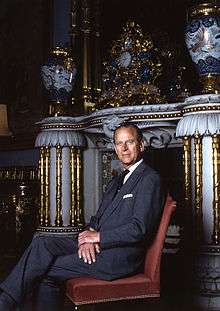
Between 1847 and 1850, when Blore was building the new east wing, the Brighton Pavilion was once again plundered of its fittings. As a result, many of the rooms in the new wing have a distinctly oriental atmosphere. The red and blue Chinese Luncheon Room is made up from parts of the Brighton Banqueting and Music Rooms with a large oriental chimney piece designed by Robert Jones and sculpted by Richard Westmacott.[53] It was formerly in the Music Room at the Brighton Pavilion.[53] The ornate clock, known as the Kylin Clock was made in Jingdezhen, Jiangxi Province, China, in the second half of the 18th century; it has a later movement by Benjamin Vulliamy circa 1820.[54] The Yellow Drawing Room has wallpaper supplied in 1817 for the Brighton Saloon, and a chimney piece which is a European vision of how the Chinese chimney piece may appear. It has nodding mandarins in niches and fearsome winged dragons, designed by Robert Jones.[55]
At the centre of this wing is the famous balcony with the Centre Room behind its glass doors. This is a Chinese-style saloon enhanced by Queen Mary, who, working with the designer Sir Charles Allom, created a more "binding"[56] Chinese theme in the late 1920s, although the lacquer doors were brought from Brighton in 1873. Running the length of the piano nobile of the east wing is the great gallery, modestly known as the Principal Corridor, which runs the length of the eastern side of the quadrangle.[57] It has mirrored doors, and mirrored cross walls reflecting porcelain pagodas and other oriental furniture from Brighton. The Chinese Luncheon Room and Yellow Drawing Room are situated at each end of this gallery, with the Centre Room obviously placed in the centre.[58]
The original early 19th-century interior designs, many of which still survive, included widespread use of brightly coloured scagliola and blue and pink lapis, on the advice of Sir Charles Long. King Edward VII oversaw a partial redecoration in a Belle époque cream and gold colour scheme.[59]
When paying a state visit to Britain, foreign heads of state are usually entertained by the Queen at Buckingham Palace. They are allocated a large suite of rooms known as the Belgian Suite, situated at the foot of the Minister's Staircase, on the ground floor of the north-facing Garden Wing. The rooms of the suite are linked by narrow corridors, one of them is given extra height and perspective by saucer domes designed by Nash in the style of Soane.[60] A second corridor in the suite has Gothic-influenced cross-over vaulting.[60] The Belgian Rooms themselves were decorated in their present style and named after Prince Albert's uncle Léopold I, first King of the Belgians. In 1936, the suite briefly became the private apartments of the palace when they were occupied by King Edward VIII.[44]
Court ceremonies
Investitures
Investitures, which include the conferring of knighthoods by dubbing with a sword, and other awards take place in the palace's Ballroom, built in 1854. At 36.6 m (120 ft) long, 18 m (59 ft) wide and 13.5 m (44 ft) high,[44] it is the largest room in the palace. It has replaced the throne room in importance and use. During investitures, the Queen stands on the throne dais beneath a giant, domed velvet canopy, known as a shamiana or a baldachin, that was used at the Delhi Durbar in 1911.[61] A military band plays in the musicians' gallery as award recipients approach the Queen and receive their honours, watched by their families and friends.[62]
State banquets
|
|
State banquets also take place in the Ballroom; these formal dinners are held on the first evening of a state visit by a foreign head of state.[62] On these occasions, for up to 170 guests in formal "white tie and decorations", including tiaras, the dining table is laid with the Grand Service, a collection of silver-gilt plate made in 1811 for the Prince of Wales, later George IV.[63] The largest and most formal reception at Buckingham Palace takes place every November when the Queen entertains members of the diplomatic corps.[64] On this grand occasion, all the state rooms are in use, as the royal family proceed through them,[65] beginning at the great north doors of the Picture Gallery. As Nash had envisaged, all the large, double-mirrored doors stand open, reflecting the numerous crystal chandeliers and sconces, creating a deliberate optical illusion of space and light.[66]
Other ceremonies and functions
Smaller ceremonies such as the reception of new ambassadors take place in the "1844 Room". Here too, the Queen holds small lunch parties, and often meetings of the Privy Council. Larger lunch parties often take place in the curved and domed Music Room, or the State Dining Room.[67] Since the bombing of the palace chapel in World War II, royal christenings have sometimes taken place in the Music Room. The Queen's first three children were all baptised there.[68] On all formal occasions, the ceremonies are attended by the Yeomen of the Guard in their historic uniforms, and other officers of the court such as the Lord Chamberlain.[67]
Former ceremonial at the Palace
Court dress
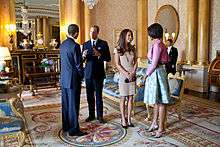
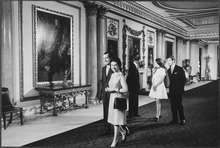
Formerly, men not wearing military uniform wore knee breeches of an 18th-century design. Women's evening dress included trains and tiaras or feathers in their hair (often both). The dress code governing formal court uniform and dress has progressively relaxed. After World War I, when Queen Mary wished to follow fashion by raising her skirts a few inches from the ground, she requested a lady-in-waiting to shorten her own skirt first to gauge the king's reaction. King George V was horrified, so the queen kept her hemline unfashionably low.[69] Following their accession in 1936, King George VI and his consort, Queen Elizabeth, allowed the hemline of daytime skirts to rise. Today, there is no official dress code.[44] Most men invited to Buckingham Palace in the daytime choose to wear service uniform or lounge suits;[44] a minority wear morning coats, and in the evening, depending on the formality of the occasion, black tie or white tie.[70]
Court presentation of débutantes
Débutantes were aristocratic young ladies making their first entrée into society through presentation to the monarch at court. These occasions, known as "coming out", took place at the palace from the reign of Edward VII. Wearing full court dress, with three ostrich feathers in their hair, débutantes entered, curtsied, and performed a backwards walk and a further curtsey, while manoeuvring a dress train of prescribed length. The ceremony, known as an evening court, corresponded to the "court drawing rooms" of Victoria's reign.[71] After World War II, the ceremony was replaced by less formal afternoon receptions, usually omitting curtsies and court dress.[72] In 1958, the Queen abolished the presentation parties for débutantes,[73] replacing them with Garden Parties,[lower-alpha 6] for up to 8,000 invitees in the Garden. They are the largest functions of the year.[75]
Security breaches
The boy Jones was an intruder who gained entry to the palace on three occasions between 1838 and 1841.[76][77] At least 12 people have managed to gain unauthorised entry into the palace or its grounds since 1914,[78] including Michael Fagan, who broke into the palace twice in 1982 and entered the Queen's bedroom on the second occasion. At the time, news media reported that he had a long conversation with the Queen while she waited for security officers to arrive, but in a 2012 interview with The Independent, Fagan said the Queen ran out of the room and no conversation took place.[79] It was only in 2007 that trespassing on the palace grounds became a specific criminal offence.[80][lower-alpha 7]
Garden and surroundings
At the rear of the palace is the large and park-like garden, which together with its lake is the largest private garden in London.[83] There, the Queen hosts her annual garden parties each summer, and also holds large functions to celebrate royal milestones, such as jubilees. It covers 40 acres (16 ha), and includes a helicopter landing area, a lake, and a tennis court.[44]
Adjacent to the palace is the Royal Mews, also designed by Nash, where the royal carriages, including the Gold State Coach, are housed. This rococo gilt coach, designed by Sir William Chambers in 1760, has painted panels by G. B. Cipriani. It was first used for the State Opening of Parliament by George III in 1762 and has been used by the monarch for every coronation since George IV. It was last used for the Golden Jubilee of Elizabeth II.[84] Also housed in the mews are the coach horses used at royal ceremonial processions.[85]
The Mall, a ceremonial approach route to the palace, was designed by Sir Aston Webb and completed in 1911 as part of a grand memorial to Queen Victoria. It extends from Admiralty Arch, across St James's Park to the Victoria Memorial. This route is used by the cavalcades and motorcades of visiting heads of state, and by the royal family on state occasions such as the annual Trooping the Colour.[86]
Modern history
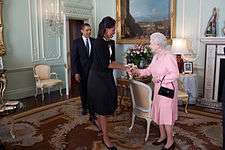
In 1901 the accession of Edward VII saw new life breathed into the palace. The new King and his wife Queen Alexandra had always been at the forefront of London high society, and their friends, known as "the Marlborough House Set", were considered to be the most eminent and fashionable of the age. Buckingham Palace—the Ballroom, Grand Entrance, Marble Hall, Grand Staircase, vestibules and galleries redecorated in the Belle Époque cream and gold colour scheme they retain today—once again became a setting for entertaining on a majestic scale but leaving some to feel King Edward's heavy redecorations were at odds with Nash's original work.[87]
The last major building work took place during the reign of King George V when, in 1913, Sir Aston Webb redesigned Blore's 1850 East Front to resemble in part Giacomo Leoni's Lyme Park in Cheshire. This new, refaced principal façade (of Portland stone) was designed to be the backdrop to the Victoria Memorial, a large memorial statue of Queen Victoria, placed outside the main gates.[88] George V, who had succeeded Edward VII in 1910, had a more serious personality than his father; greater emphasis was now placed on official entertaining and royal duties than on lavish parties.[89] He arranged a series of command performances featuring jazz musicians such as the Original Dixieland Jazz Band (1919) – the first jazz performance for a head of state, Sidney Bechet, and Louis Armstrong (1932), which earned the palace a nomination in 2009 for a (Kind of) Blue Plaque by the Brecon Jazz Festival as one of the venues making the greatest contribution to jazz music in the United Kingdom.[90][91] George V's wife Queen Mary was a connoisseur of the arts, and took a keen interest in the Royal Collection of furniture and art, both restoring and adding to it. Queen Mary also had many new fixtures and fittings installed, such as the pair of marble Empire-style chimneypieces by Benjamin Vulliamy, dating from 1810, which the Queen had installed in the ground floor Bow Room, the huge low room at the centre of the garden façade. Queen Mary was also responsible for the decoration of the Blue Drawing Room.[92] This room, 69 feet (21 metres) long, previously known as the South Drawing Room, has a ceiling designed specially by Nash, coffered with huge gilt console brackets.[93]
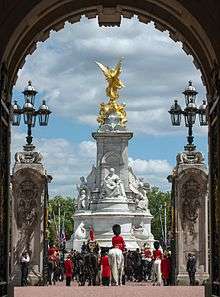
During World War I, the palace, then the home of King George V and Queen Mary, escaped unscathed. Its more valuable contents were evacuated to Windsor but the royal family remained in situ. The King imposed rationing at the palace, much to the dismay of his guests and household.[94] To the King's later regret, David Lloyd George persuaded him to go further by ostentatiously locking the wine cellars and refraining from alcohol, to set a good example to the supposedly inebriated working class. The workers continued to imbibe and the King was left unhappy at his enforced abstinence.[95] In 1938, the north-west pavilion, designed by Nash as a conservatory, was converted into a swimming pool.[96]
During World War II, the palace was bombed nine times,[97] the most serious and publicised of which resulted in the destruction of the palace chapel in 1940. Coverage of this event was played in cinemas all over the UK to show the common suffering of rich and poor. One bomb fell in the palace quadrangle while King George VI and Queen Elizabeth were in residence, and many windows were blown in and the chapel destroyed.[98] War-time coverage of such incidents was severely restricted, however. The King and Queen were filmed inspecting their bombed home, the smiling Queen, as always, immaculately dressed in a hat and matching coat seemingly unbothered by the damage around her. It was at this time the Queen famously declared: "I'm glad we have been bombed. Now I can look the East End in the face". The royal family were seen as sharing their subjects' hardship, as The Sunday Graphic reported:
By the Editor: The King and Queen have endured the ordeal which has come to their subjects. For the second time a German bomber has tried to bring death and destruction to the home of Their Majesties ... When this war is over the common danger which King George and Queen Elizabeth have shared with their people will be a cherished memory and an inspiration through the years.[99]
On 15 September 1940, known as the Battle of Britain Day, an RAF pilot, Ray Holmes of No. 504 Squadron RAF rammed a German bomber he believed was going to bomb the Palace. Holmes had run out of ammunition and made the quick decision to ram it. Holmes bailed out. Both aircraft crashed. In fact the Dornier Do 17 bomber was empty. It had already been damaged, two of its crew had been killed and the remainder bailed out. Its pilot, Feldwebel Robert Zehbe, landed, only to die later of wounds suffered during the attack. During the Dornier's descent, it somehow unloaded its bombs, one of which hit the Palace. It then crashed into the forecourt of London Victoria station.[100] The bomber's engine was later exhibited at the Imperial War Museum in London. The British pilot became a King's Messenger after the war, and died at the age of 90 in 2005.[101]
On VE Day—8 May 1945—the palace was the centre of British celebrations. The King, Queen, Princess Elizabeth (the future Queen), and Princess Margaret appeared on the balcony, with the palace's blacked-out windows behind them, to the cheers from a vast crowd in the Mall.[102] The damaged Palace was carefully restored after the War by John Mowlem & Co.[103] It was designated a Grade I listed building in 1970.[104]
21st century: Royal use and public access
Every year, some 50,000 invited guests are entertained at garden parties, receptions, audiences, and banquets. Three garden parties are held in the summer, usually in July.[105] The forecourt of Buckingham Palace is used for Changing of the Guard, a major ceremony and tourist attraction (daily from April to July; every other day in other months).[106]
.jpg)
The palace, like Windsor Castle, is owned by the reigning monarch in right of the Crown. It is not the monarch's personal property, unlike Sandringham House and Balmoral Castle.[107] Many of the contents from Buckingham Palace, Windsor Castle, Kensington Palace, and St James's Palace are part of the Royal Collection, held in trust by the Sovereign; they can, on occasion, be viewed by the public at the Queen's Gallery, near the Royal Mews. Unlike the palace and the castle, the purpose-built gallery is open continually and displays a changing selection of items from the collection.[108] It occupies the site of the chapel destroyed by an air raid in World War II.[17] The palace's state rooms have been open to the public during August and September and on selected dates throughout the year since 1993. The money raised in entry fees was originally put towards the rebuilding of Windsor Castle after the 1992 fire devastated many of its state rooms.[109] In the year to 31 March 2017, 580,000 people visited the palace, and 154,000 visited the gallery.[110]
Her Majesty's Government is responsible for maintaining the palace in exchange for the profits made by the Crown Estate.[111] In November 2015, the State Dining Room was closed for six months because its ceiling had become potentially dangerous.[112] A 10-year schedule of maintenance work, including new plumbing, wiring, boilers, and radiators, and the installation of solar panels on the roof, has been estimated to cost £369 million and was approved by the prime minister in November 2016. It will be funded by a temporary increase in the Sovereign Grant paid from the income of the Crown Estate and is intended to extend the building's working life by at least 50 years.[113][114] In March 2017, the House of Commons backed funding for the project by 464 votes to 56.[115]
Thus, Buckingham Palace is a symbol and home of the British monarchy, an art gallery, and a tourist attraction. Behind the gilded railings and gates that were completed by the Bromsgrove Guild in 1911[43] and Webb's famous façade, which has been described in a book published by the Royal Collection Trust as looking "like everybody's idea of a palace",[43] is not only a weekday home of the Queen and Prince Philip but also the London residence of the Duke of York and the Earl and Countess of Wessex. The palace also houses their offices, as well as those of the Princess Royal and Princess Alexandra, and is the workplace of more than 800 people.[44]
See also
Notes
- ↑ By tradition, the British Royal Court is officially resident at St James's Palace, which means that, while foreign ambassadors assuming their new position are received by the British sovereign at Buckingham Palace, they are accredited to the "Court of St James's Palace". This anomaly continues for the sake of tradition, as Buckingham Palace is to all intents and purposes the official residence. See History of St James's Palace (Official website of the British Monarchy).
- ↑ The topography of the site and its ownership are dealt with in Wright, chapters 1–4.
- ↑ Audley and Davies were key figures in the development of Ebury Manor and also the Grosvenor Estate (see Dukes of Westminster), which still exists today. They are remembered in the streetnames North Audley Street, South Audley Street, and Davies Street, all in Mayfair.
- ↑ The purchase price is given by Wright p. 142 as £28,000.
- ↑ The tradition persists of foreign ambassadors being formally accredited to "the Court of St James's", even though it is at Buckingham Palace that they present their credentials and staff to the Monarch upon their appointment.
- ↑ Princess Margaret is reputed to have remarked of the débutante presentations: "We had to put a stop to it, every tart in London was getting in."[74]
- ↑ Under section 128(1) of the Serious Organised Crime and Police Act 2005, "A person commits an offence if he enters, or is on, any designated site in England and Wales or Northern Ireland as a trespasser".[81] Buckingham Palace is a designated site under the Serious Organised Crime and Police Act 2005 (Designated Sites under Section 128) Order 2007.[82]
References
- ↑ "Buckingham". Collins Dictionary. n.d. Retrieved 23 September 2014.
- ↑ "Palace". Collins Dictionary. n.d. Retrieved 23 September 2014.
- ↑ Royal Household. "Buckingham Palace". Royal Family website. Retrieved 21 April 2016.
- 1 2 Robinson, p. 14.
- ↑ Goring, p. 15.
- ↑ Goring, p. 28.
- ↑ Goring, p. 18.
- ↑ "Chapter 1: The Acquisition of the Estate". The Grosvenor Estate in Mayfair. Survey of London. 39. London County Council. 1977. pp. 1–5. Retrieved 3 February 2009.
- ↑ Wright, pp. 76–78.
- ↑ Goring, pp. 31, 36.
- ↑ Wright, p. 83.
- ↑ Goring, Chapter V
- 1 2 3 Harris, p. 21.
- ↑ Wright, p. 96.
- ↑ Goring, p. 62.
- ↑ Goring, p. 58.
- 1 2 "Who built Buckingham Palace?". Royal Collection Trust. Retrieved 8 March 2016.
- ↑ Harris, p. 22.
- ↑ Mackenzie, p. 12 and Nash, p. 18.
- ↑ Mackenzie, p. 12
- ↑ Harris, p. 24.
- 1 2 Old and New London. 4. Cassell, Petter & Galpin. 1878. pp. 61–74.
- ↑ Jones, p. 42.
- ↑ Burke, Edmund, ed. (1791). The Annual Register. p. 8. Retrieved 25 September 2016.
Buckingham-palace was the dwelling house of the king.
- ↑ Harris, pp. 30–31.
- ↑ Harris, p. 33.
- ↑ "The Royal Residences > Buckingham Palace > History". www.royal.gov.uk. Archived from the original on 28 March 2010.
- ↑ Ziegler, Phillip (1971). King William IV. Collins. p. 280. ISBN 0-00-211934-X.
- ↑ "The Royal Residences > Buckingham Palace". www.royal.gov.uk. Archived from the original on 27 March 2010.
- ↑ Hedley, p. 10.
- 1 2 Woodham-Smith, p. 249.
- 1 2 Rappaport, p. 84.
- ↑ Harris, de Bellaigue & Miller, p. 33.
- ↑ Holland & Hannen and Cubitts – The Inception and Development of a Great Building Firm, published 1920, p. 35.
- ↑ Owens, Ed. "Buckingham Palace's balcony: a focal point for national celebration". Immediate Media/BBC. Retrieved 12 June 2017.
- ↑ King, p. 217.
- ↑ Hedley, p. 19.
- ↑ Healey, pp. 137–138.
- ↑ Healey, p. 122.
- ↑ Allen's Indian Mail, and Register of Intelligence for British and Foreign India, China, and All Parts of the East. 8. 1850. p. 117.
- ↑ "Who has lived at Buckingham Palace?". Royal Collection Trust. Archived from the original on 12 June 2017. Retrieved 12 June 2017.
- ↑ John Gardiner (2006). The Victorians: An Age in Retrospect. A&C Black. p. 142. ISBN 978-1-85285-560-4.
- 1 2 3 Robinson, p. 9.
- 1 2 3 4 5 6 7 8 "40 facts about Buckingham Palace". British Monarchy website. Archived from the original on 4 November 2011.
- ↑ Robinson, p. 11.
- ↑ "Queen honours jeweller with top personal award". Times of Tunbridge Wells. 6 January 2016. Retrieved 2 June 2016.
- 1 2 Harris, p. 41.
- ↑ Harris, pp. 78–79 and Healey, pp. 387–388.
- ↑ "Visit the State Rooms, Buckingham Palace". Royal Collection Trust. Retrieved 7 February 2016.
- ↑ Harris, p. 81.
- ↑ Harris, p. 40.
- ↑ Jerrold M. Packard (1982). The Queen and Her Court: A Guide to the British Monarchy Today. Simon & Schuster. p. 48. ISBN 978-0-684-17648-2.
- 1 2 Harris, de Bellaigue & Miller, p. 87.
- ↑ Harris, de Bellaigue & Miller, p. 135.
- ↑ Healey, pp. 159–160.
- ↑ Harris, de Bellaigue & Miller, p. 93.
- ↑ Harris, de Bellaigue & Miller, p. 91.
- ↑ John Harris; Geoffrey De Bellaigue; Oliver Millar (1968). Buckingham Palace and its Treasures. Viking Press. p. 90.
- ↑ Jones, p. 43.
- 1 2 Harris, p. 82.
- ↑ Harris, p. 72.
- 1 2 Healey, p. 364.
- ↑ "Royal seal of approval for state banquet exhibition". The Telegraph. London. 25 July 2008. Retrieved 31 January 2016.
- ↑ Healey, p. 362.
- ↑ Hedley, p. 16.
- ↑ Robinson, p. 18.
- 1 2 Healey, pp. 363–365.
- ↑ Robinson, p. 49.
- ↑ Healey, p. 233, quoting The Memoirs of Mabell, Countess of Airlie, edited and arranged by Jennifer Ellis, London: Hutchinson, 1962.
- ↑ Anthony Seldon (1999). 10 Downing Street: The Illustrated History. Harper Collins Illustrated. p. 202. ISBN 978-0-00-414073-5.
- ↑ Peacocke, pp. 178–179, 244–247.
- ↑ Peacocke, pp. 264–265.
- ↑ "Mailbox". Royal Insight Magazine. Archived from the original on 23 January 2008. Retrieved 23 January 2008.
- ↑ Blaikie, Thomas (2002). You look awfully like the Queen. London: Harper Collins. ISBN 0-00-714874-7.
- ↑ Royal Household. "Garden parties: The guests". Official Website of the British Monarchy. Archived from the original on 17 January 2013.
- ↑ Punch, Volume 1: July–December 1841.
- ↑ Dickens, Charles (5 July 1885) "The boy Jones", All the Year Round, pp. 234–37.
- ↑ Pam Tobey (24 September 2014). "Remember the guy who got into the Queen's bedroom?". The Washington Post. Retrieved 21 June 2016.
- ↑ Dugan, Emily (19 February 2012). "Michael Fagan: 'Her nightie was one of those Liberty prints, down to her knees'". The Independent on Sunday. Retrieved 4 January 2014.
- ↑ "Trespass law targets royal sites". BBC News. 24 March 2007. Retrieved 27 February 2016.
- ↑ "Serious Organised Crime and Police Act 2005". Legislation.gov.uk. 7 January 2005. Retrieved 11 June 2017.
- ↑ "The Serious Organised Crime and Police Act 2005 (Designated Sites under Section 128) Order 2007". Legislation.gov.uk. 1 June 2007. Retrieved 11 June 2017.
- ↑ "Buckingham Palace". Archived from the original on 2 May 2008. Retrieved 3 February 2009. (Museum of London.) Retrieved 2 May 2009.
- ↑ "Gold State Coach". Royal Collection Trust. Inventory no. 5000048.
- ↑ "The Royal Residences > The Royal Mews". www.royal.gov.uk. Archived from the original on 10 July 2009.
- ↑ Nicholson, Louise (1998). London. London: Frances Lincoln. p. 56. ISBN 0-7112-1187-6.
- ↑ Robinson (Page 9) asserts that the decorations, including plaster swags and other decorative motifs, are "finicky" and "at odds with Nash's original detailing".
- ↑ Harris, p. 34.
- ↑ Healey, p. 185.
- ↑ "Buckingham Palace hits right note with jazz fans". London Evening Standard. 3 August 2009. Archived from the original on 26 April 2010. Retrieved 11 August 2010.
- ↑ Stephen Bates (3 August 2009). "By royal approval: Buckingham Palace's place in jazz history". The Guardian. London. Retrieved 11 August 2010.
- ↑ Healey pp. 221–222.
- ↑ Harris, p. 63.
- ↑ Rose, Kenneth (1983). King George V. London: Weidenfeld and Nicolson. pp. 176–177. ISBN 0-297-78245-2.
- ↑ Rose, pp. 178–179.
- ↑ Allison and Riddell, p. 69.
- ↑ "Letter from Queen Elizabeth to Queen Mary describing the bombing of Buckingham Palace, 13 September 1940". Royal Collection Trust. Retrieved 31 March 2016.
- ↑ Thornton, Michael (1984). Royal Feud. M. Joseph. p. 216.
- ↑ The Sunday Graphic, 18 September 1939, p. 1.
- ↑ Price, Alfred. The Battle of Britain Day, Greenhill Books, London, 1990, pp. 49–50 and Stephen Bungay, The Most Dangerous Enemy: A History of the Battle of Britain. Aurum Press, London, 2000, p. 325.
- ↑ "Pilot who 'saved Palace' honoured". BBC News. 2 November 2005. Retrieved 18 March 2009.
- ↑ 1945: Rejoicing at end of war in Europe (BBC On this day.) Retrieved 3 February 2009.
- ↑ "Sir Edgar Beck". The Telegraph. London. 9 August 2000. Retrieved 5 June 2012.
- ↑ Historic England. "Buckingham Palace (Grade I) (1239087)". National Heritage List for England. Retrieved 18 November 2016.
- ↑ "About Buckingham Palace". Royal Collection Trust. 8 March 2016.
- ↑ "Changing the Guard". Royal Collection Trust. Retrieved 8 March 2016.
- ↑ "Royal Property". Parliamentary Debates (Hansard). 252. United Kingdom: House of Commons. 16 January 1995. col. 301W.
- ↑ "About the Royal Collection". Royal Collection Trust. Retrieved 8 March 2016.
- ↑ "Windsor Castle – five years from disaster to triumph". BBC. 17 November 1997. Retrieved 8 March 2016.
- ↑ Royal Collection Enterprises Limited (28 September 2017). "Full accounts made up to 31 March 2017". Companies House. p. 3. Retrieved 6 February 2018.
- ↑ HM Treasury. "Sovereign Grant Act: frequently asked questions relating to the Act and on general issues". The National Archives. Archived from the original on 29 January 2013. Retrieved 22 May 2016.
- ↑ "Buckingham Palace dining room closed over ceiling safety concerns". The Guardian. Press Association. 30 November 2015. Retrieved 28 May 2018.
- ↑ Gordon Rayner (18 November 2016). "Queen to remain in residence as Buckingham Palace gets £369m taxpayer-funded facelift to avert 'catastrophic building failure'". The Telegraph. Retrieved 18 November 2016.
- ↑ "Buckingham Palace to get £369m refurbishment". BBC News. 18 November 2016. Retrieved 18 November 2016.
- ↑ "Buckingham Palace repairs funding approved by MPs". BBC News. 15 March 2017.
Bibliography
- Allison, Ronald; Riddell, Sarah (1991). The Royal Encyclopedia. London: Macmillan. ISBN 0-333-53810-2
- Blaikie, Thomas (2002). You Look Awfully Like the Queen: Wit and Wisdom from the House of Windsor. London: Harper Collins. ISBN 0-00-714874-7.
- Goring, O. G. (1937). From Goring House to Buckingham Palace. London: Ivor Nicholson & Watson.
- Harris, John; de Bellaigue, Geoffrey; & Miller, Oliver (1968). Buckingham Palace. London: Nelson. ISBN 0-17-141011-4.
- Healey, Edma (1997). The Queen's House: A Social History of Buckingham Palace. London: Penguin Group. ISBN 0-7181-4089-3.
- Hedley, Olwen (1971) The Pictorial History of Buckingham Palace. Pitkin, ISBN 0-85372-086-X.
- Jones, Nigel R. (2005). Architecture of England, Scotland, and Wales. Greenwood Publishing Group. ISBN 0-313-31850-6.
- King, Greg (2007). Twilight of Splendor: The Court of Queen Victoria During Her Diamond Jubilee Year. John Wiley & Sons. ISBN 978-0-470-04439-1.
- Mackenzie, Compton (1953). The Queen's House. London: Hutchinson.
- Nash, Roy (1980). Buckingham Palace: The Place and the People. London: Macdonald Futura. ISBN 0-354-04529-6.
- Peacocke, M. D. (1951). The Story of Buckingham Palace. London: Odhams Press.
- Rappaport, Helen (2003). Queen Victoria: A Biographical Companion. ABC-CLIO. ISBN 978-1-85109-355-7.
- Robinson, John Martin (1999). Buckingham Palace. Published by The Royal Collection, St James's Palace, London ISBN 1-902163-36-2.
- Williams, Neville (1971). Royal Homes. Lutterworth Press. ISBN 0-7188-0803-7.
- Woodham-Smith, Cecil (1973). Queen Victoria (vol 1) Hamish Hamilton Ltd.
- Wright, Patricia (1999; first published 1996). The Strange History of Buckingham Palace. Stroud, Gloucs.: Sutton Publishing Ltd. ISBN 0-7509-1283-9.
External links
| Wikimedia Commons has media related to Buckingham Palace. |
| Wikivoyage has a travel guide for Buckingham Palace. |
- Buckingham Palace at the Royal Family website
- Account of Buckingham Palace, with prints of Arlington House and Buckingham House from Old and New London (1878)
- Account of the acquisition of the Manor of Ebury from Survey of London (1977)
- The State Rooms, Buckingham Palace at the Royal Collection Trust
